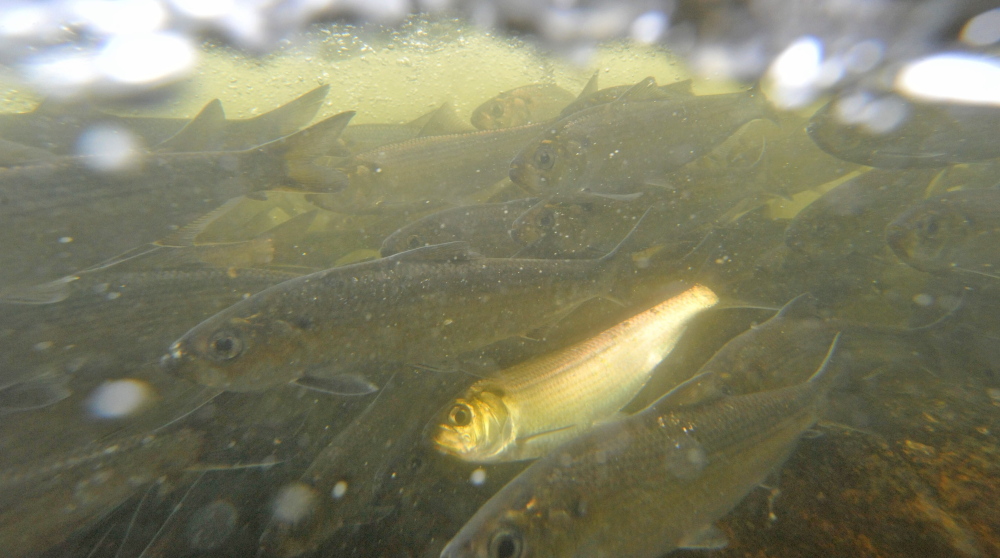CHAMCOOK, New Brunswick — Alewives, the herring-like fish that traditionally spawned in Maine’s lakes and rivers, have had a banner spawning run in the St. Croix River, from which they had been banned for nearly two decades by acts of the Maine Legislature.
As of Tuesday morning, 88,685 alewives had entered the river via a fishway at the dam in Milltown, New Brunswick, across from Calais, according to Graham Chafe of the Atlantic Salmon Federation, which has assisted the St. Croix International Waterway Commission in monitoring the small river-run fish. In 2014, only 26,798 alewives entered the river to spawn. Their annual run now appears nearly complete, as only a few dozen fish passed Milltown in recent days.
“The numbers are the biggest in nearly 20 years, and that’s good news,” said Chafe, who noted that eight Atlantic shad had also entered the river, a species not seen in previous years.
The return of alewives to the St. Croix river system – which straddles the Maine-New Brunswick border – has been celebrated by the U.S. and Canadian federal governments, the Passamaquoddy Indian tribe, conservationists and marine fishermen, all of whom point to broad agreement among scientists that the fish will benefit the ecosystem.
Fishing guides in the upper watershed have been deeply opposed, however, fearing harm to the smallmouth bass on which their livelihoods rely. They made an unsuccessful bid this spring to get the Legislature to close the river to the fish.
Conservationists note that the increased numbers are not due to the fish being allowed since 2013 to travel through the fishway at the Grand Falls Dam in Baileyville and on into hundreds of square miles of lakes, streams, and river beyond. Any fish hatched since then are still at sea, not yet old enough to return to the St. Croix for their first spawning, which occurs at about age 3.
Rather, Chafe said, the increase correlates to the opening of a short section of the lower river in 2008, when legislators allowed alewives to pass over the Woodland Dam, 10 miles upstream from Milltown and Calais.
“What we’re seeing are the benefits of that 2008 removal, and we’ll see an even bigger benefit in the coming years from the 2013 removal,” he said, speaking of the removal of barriers that had blocked the fish from entering dam fish ladders.
Alewives were effectively shut out of the St. Croix River from 1825 to 1981, first because of impassable dams, and later because of pollution from lumber and paper mills. Meanwhile, smallmouth bass were introduced to the region by late- 19th century sport fishermen, supporting fishing camps and guides across the watershed.
But with construction of a better fishway at the dam at the mouth of the river in the early 1980s, the alewives’ annual run grew 13-fold to more than 2.6 million fish. Bass guides worried about the possible effects on smallmouth bass and persuaded Augusta lawmakers to pass a 1995 law that ordered the fishways at the Grand Falls and the Woodland dams – which are controlled from the Maine side of the river – to be closed to the fish. The St. Croix alewife runs collapsed to just 900 fish in 2002, a decline of 99.7 percent.
The Legislature considered lifting the ban in 2008, but under pressure from guides and William Nicholas, then and now the chief of the Passamaquoddy Tribe’s Indian Township reservation, ultimately decided to leave the Grand Falls fishway closed, depriving the alewives of an estimated 94 percent of their habitat.
In 2013, lawmakers effectively rescinded the 1995 and 2008 laws, allowing alewives to pass freely through much of the St. Croix watershed, which scientists estimate could support a spawning run of at least 10 million fish.
Send questions/comments to the editors.


